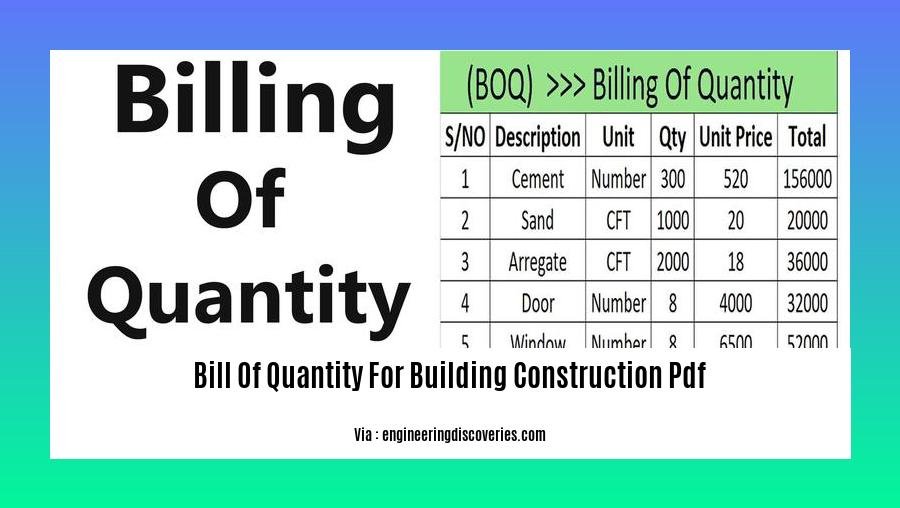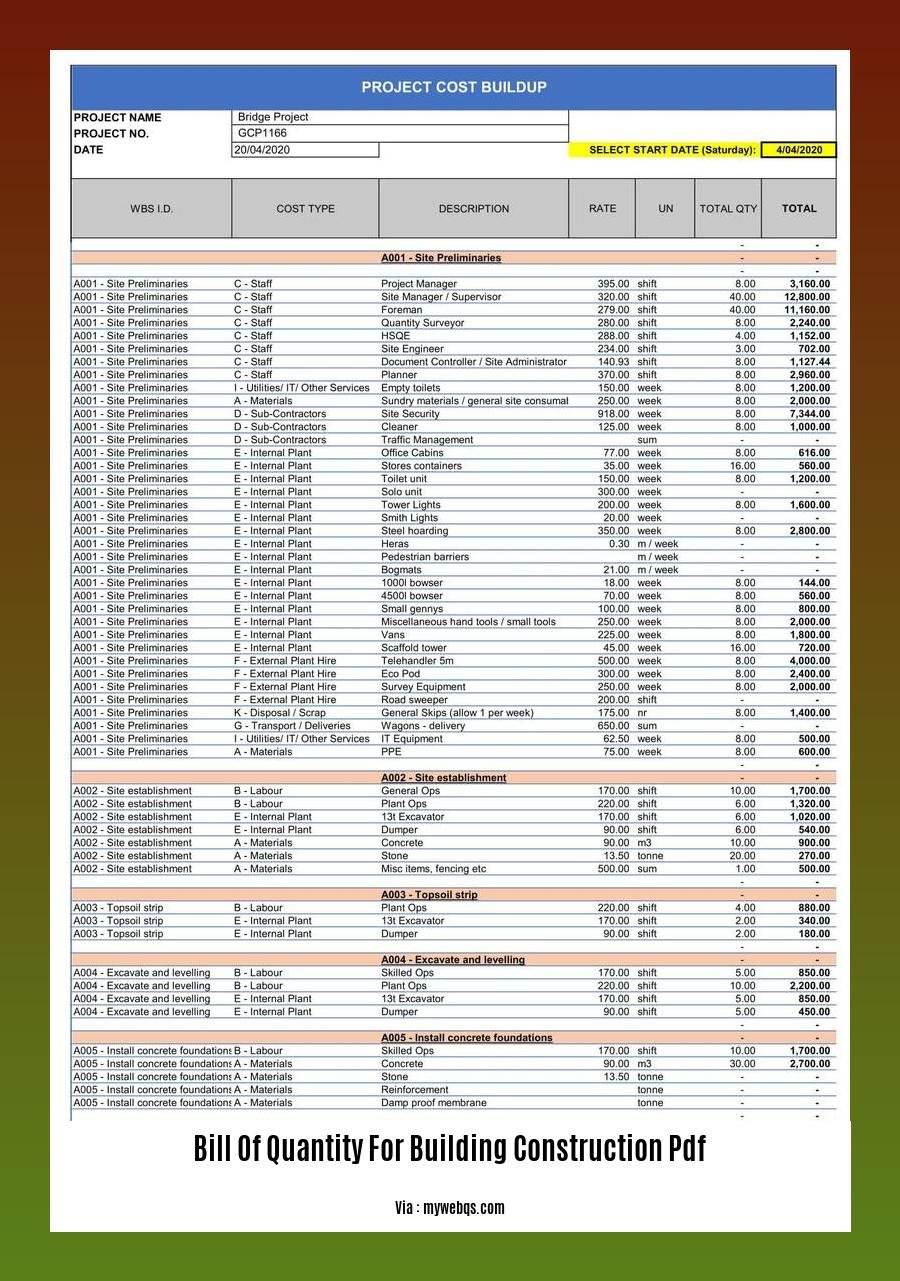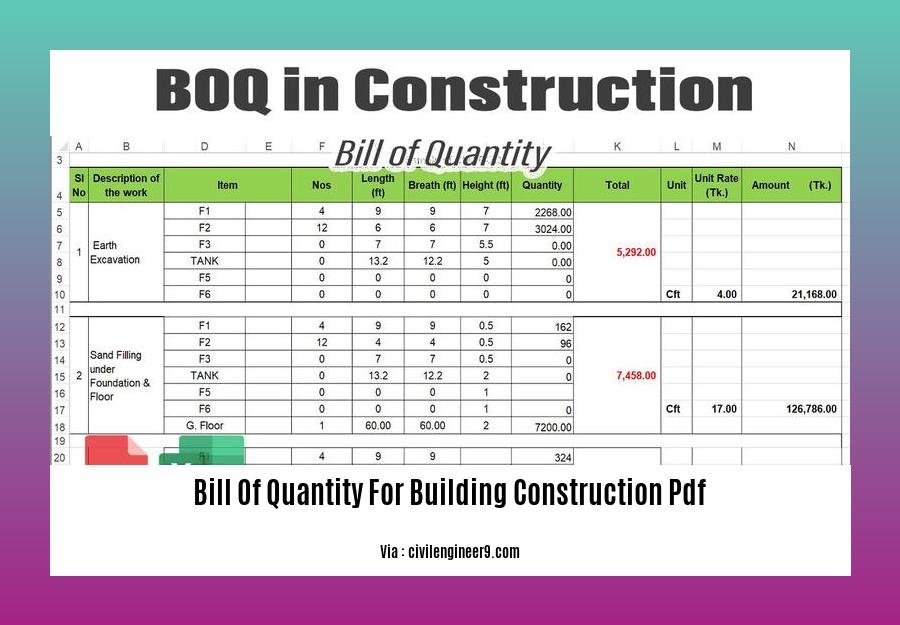Accurate Bill of Quantity for Building Construction PDF: A Guide for Effective Project Execution.In the realm of construction, the Bill of Quantities (BOQ) stands as a cornerstone document, providing a detailed breakdown of the materials, labor, and equipment required to complete a building project. It plays a pivotal role in project planning, cost estimation, and ensuring efficient resource allocation. This guide delves into the intricacies of BOQs, empowering you to harness their potential for effective project execution, minimizing risks, and delivering successful construction outcomes.
Key Takeaways:
- BOQs provide accurate cost estimates for efficient resource allocation.
- They facilitate effective project management by outlining requirements and timelines.
- BOQs serve as contractual documents, defining scope and costs.
- They ensure transparency, reducing disputes and corrupt practices.
- BOQs detail materials, quantities, and aid in procurement.
- They monitor project progress and ensure timely completion within budget.
Bill of Quantity for Building Construction PDF: A Practical Guide

A bill of quantity (BOQ) is a detailed document that lists down the materials, labor, and other resources required for a construction project, along with their respective quantities and costs.
It serves as a crucial tool for project management, cost estimation, and contract administration.
What are the functions of a BOQ?
A BOQ serves several important functions:
- Provides detailed specifications for materials, labor, and quantities.
- Aids in cost estimation and budgeting.
- Facilitates accurate purchasing and procurement of materials.
- Monitors project progress and ensures completion within budget and timeframe.
How to create a BOQ?
Creating a comprehensive BOQ involves several steps:
- Gather project information: Collect all relevant project documents, such as drawings, specifications, and contract documents.
- Identify materials and labor: Create a list of all materials, labor, and other resources required for the project.
- Determine quantities: Determine the quantities of each item based on the project documentation.
- Obtain unit costs: Research and obtain unit costs for each item from suppliers or contractors.
- Calculate total costs: Multiply the quantities by the unit costs to calculate the total cost of each item.
- Review and finalize: Review the BOQ carefully and make any necessary adjustments. Finalize the document once it is complete.
Benefits of using a BOQ:
- Enhanced cost control
- Improved project planning
- Increased transparency
- Reduced project risks
- Improved communication among project stakeholders
Conclusion:
A well-prepared bill of quantity is an indispensable tool for successful construction projects. It provides a clear and detailed roadmap for project execution, ensuring accurate cost estimation, efficient resource allocation, and timely completion. By following the steps outlined above, you can create a comprehensive BOQ that will guide your project to a successful outcome.
- For a comprehensive resource on the Bihar Police Building Construction Corporation, navigate to this link.
- Acquire a comprehensive understanding of building construction project requirements by accessing the BOQ of Building Construction Project PDF here.
Interpretation of BOQs for Accurate Project Estimation

Interpreting Bills of Quantities (BOQs) is crucial for accurate project estimation in building construction. A BOQ outlines the materials, labor, and other resources needed for a project, providing a detailed breakdown of quantities and costs. A well-interpreted BOQ enables project managers and contractors to make informed decisions and ensure efficient resource allocation.
Key Steps in Interpreting BOQs
-
Review Project Scope: Begin by thoroughly understanding the project scope, including its objectives, specifications, and timelines. This context will help you grasp the project’s requirements.
-
Quantity Analysis: Carefully examine the quantities listed in the BOQ. Ensure that they are accurate and align with the project scope. Verify the units of measurement and identify any discrepancies.
-
Cost Analysis: Analyze the unit costs and labor rates provided in the BOQ. Consider market trends, supplier quotes, and historical data to ensure that the costs are realistic and up-to-date.
-
Resource Allocation: Based on the quantities and costs, plan the allocation of resources. Determine the type and amount of materials required, estimate the labor hours needed, and identify any specialized equipment or subcontractors necessary.
-
Contingency Planning: Anticipate potential changes or disruptions during construction. Incorporate a contingency budget and plan to account for unexpected expenses or delays.
Benefits of Accurate BOQ Interpretation
- Precise cost estimation and budget control.
- Optimized resource allocation and procurement planning.
- Improved project scheduling and risk management.
- Enhanced communication and transparency among stakeholders.
- Increased likelihood of successful project delivery on time and within budget.
Key Takeaways:
- BOQs provide a detailed and comprehensive overview of project requirements and costs.
- Accurate BOQ interpretation is essential for informed decision-making and efficient resource allocation.
- Key steps in BOQ interpretation include project scope review, quantity analysis, cost analysis, resource allocation, and contingency planning.
- Benefits of accurate BOQ interpretation include cost precision, optimized resource allocation, improved project planning, enhanced communication, and increased project success.
Citations:
- How to Read and Understand a Bill of Quantities (BOQ)
- Bill of Quantities Example (PDF + Advantages for a BOQ)
Utilizing BOQs for Cost Control and Procurement
Key Takeaways:
- BOQs provide a detailed breakdown of project costs, enabling effective cost control.
- They facilitate accurate procurement by listing the required materials and quantities.
- BOQs enhance transparency and accountability in project execution.
- By identifying cost deviations early on, BOQs help prevent cost overruns.
- They streamline the procurement process by providing a clear understanding of project requirements.
What is a Bill of Quantities (BOQ)?
A BOQ is a comprehensive document that provides a detailed list of all materials, labor, and resources required for a construction project. It includes quantities, descriptions, and unit costs, as well as overall project costs.
Utilizing BOQs for Cost Control
BOQs play a crucial role in cost control by:
- Providing a clear and detailed breakdown of project costs.
- Allowing for accurate estimation of project expenses.
- Identifying deviations from planned quantities or costs.
- Enabling proactive cost management and mitigation of cost overruns.
Utilizing BOQs for Procurement
BOQs facilitate efficient procurement by:
- Listing all required materials and quantities in a single document.
- Providing clear specifications and descriptions for materials.
- Streamlining the bidding process for contractors.
- Promoting transparency in procurement decisions.
Conclusion
BOQs are indispensable tools in construction project management. They ensure cost-effective project execution by providing a comprehensive view of project costs and procurement requirements. By utilizing BOQs for cost control and procurement, project managers can enhance project efficiency, minimize risks, and deliver successful outcomes.
Relevant URL Sources
- Applicability Bill of Quantities in Construction Procurement
- Importance and Functions of Bills of Quantities in the Construction Industry: A Content Analysis
Leveraging Technology for Efficient BOQ Management
In construction, the preparation of accurate bills of quantities (BOQs) is essential for efficient project execution. Technology has revolutionized this process, enabling a higher degree of accuracy, speed, and transparency. Here’s a guide to leveraging technology for efficient BOQ management:
AI-Powered BOQ Generation
AI algorithms can analyze project plans, specifications, and BIM data to create precise BOQs automatically. This eliminates manual labor, reduces errors, and significantly decreases the turnaround time for BOQ creation.
Integration with Project Management Software
Advanced project management software allows seamless integration with BOQ data. This real-time connection ensures that changes in project plans or costs are immediately reflected in the BOQ, preventing discrepancies.
Digital Document Collaboration
Cloud-based platforms facilitate secure collaboration on BOQs among project stakeholders. This streamlines communication, enables remote access, and eliminates the need for physical document handling, improving efficiency and transparency.
Automated Quantity Takeoffs
Digital tools can perform automated quantity takeoffs based on 3D models or 2D drawings. This eliminates the need for manual counting and measurements, increasing accuracy and reducing the risk of human error.
Cost Management and Control
Technology-enabled BOQs provide real-time cost information, allowing project managers to track expenses and make informed decisions. This facilitates cost control and optimization throughout the project lifecycle.
Key Takeaways:
- AI and automated tools significantly improve the accuracy, speed, and efficiency of BOQ creation.
- Integration with project management software ensures up-to-date BOQ data and streamlined collaboration.
- Digital document collaboration platforms enhance transparency and remote access to BOQ data.
- Automated quantity takeoffs eliminate manual errors and increase accuracy.
- Technology-enabled BOQs provide real-time cost information for effective cost control.
Relevant URL Sources:
- Automating Bill of Quantities Takeoff Using Artificial Intelligence and Machine Learning
- BIM-Integrated Automated Quantification for Enhanced Quantity Surveying and Bill of Quantities
FAQ
Q1: What are the key benefits of using a Bill of Quantity (BOQ) for building construction?
Q2: How do I ensure the accuracy of my BOQ for building construction?
Q3: What are the best practices for creating a comprehensive BOQ for building construction?
Q4: Where can I find a free downloadable PDF template for a bill of quantity for building construction?
Q5: How can I use a BOQ to effectively manage project costs and stay within budget?
- Are Daffodils Perennials?A Complete Guide to Planting & Care - March 31, 2025
- Are Carpenter Bees Dangerous? Stings, Damage, and Control - March 31, 2025
- How to Get Rid of Ants in the Washroom: A Complete Guide - March 31, 2025










